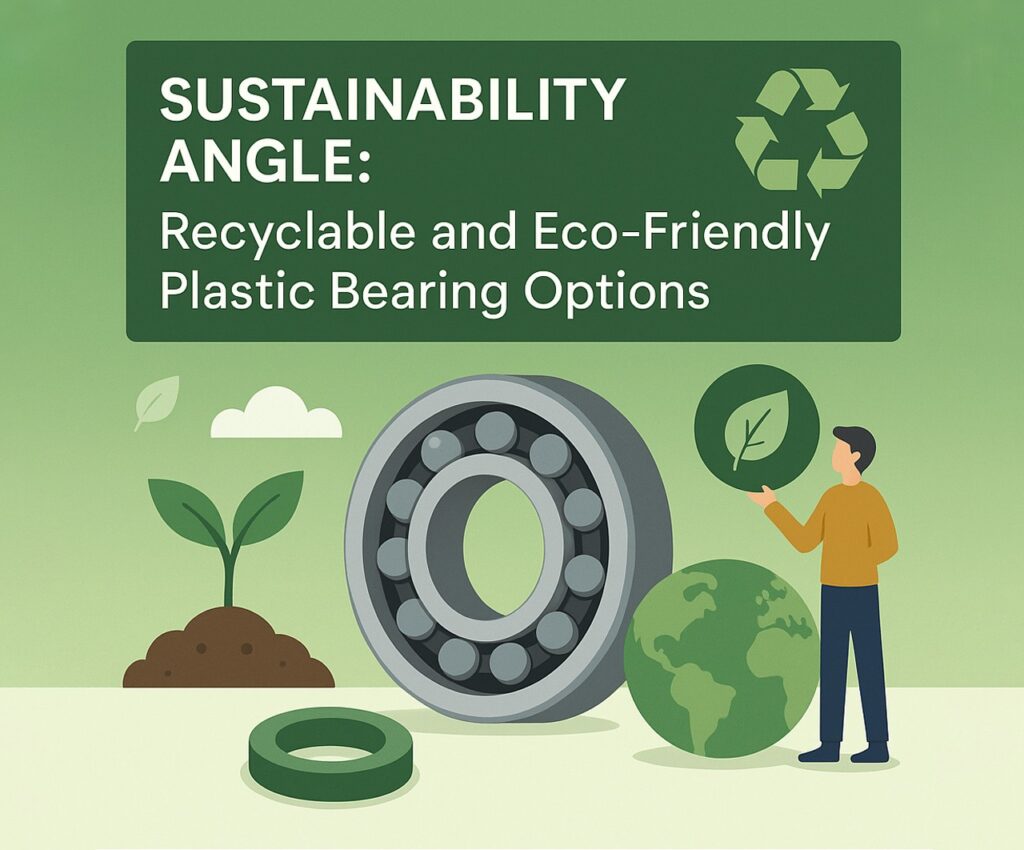In a world shifting toward greener manufacturing and smarter engineering, components like self lubricating plastic, plastic sleeve bushing, and flanged bushing plastic are gaining traction—not just for performance but for their sustainability potential. These seemingly small parts are playing a big role in reducing environmental impact across a wide range of industries, from automotive to agriculture. This article explores how eco-friendly plastic bearings are reshaping maintenance practices, product lifecycles, and environmental footprints. Know More
The Push for Sustainable Engineering
Traditional metal bearings come with baggage—mining impact, energy-intensive processing, and difficulty in recycling. Meanwhile, modern plastic bearings are not only lighter and quieter but are also increasingly being made from recyclable and biodegradable materials. The demand for green components has driven manufacturers to develop options like self lubricating plastic bushings that require no additional oil or grease, reducing pollution and simplifying disposal.
Why Plastic Bearings Are a Green Alternative
Let’s start with the core environmental benefits:
- No External Lubrication Needed: A key feature of self lubricating plastic is its internal lubrication, eliminating the need for oils or greases that could contaminate ecosystems.
- Lightweight = Less Energy: Lower mass reduces fuel and electricity consumption in transportation and operation.
- Recyclability: Many high-performance plastics like POM and nylon can be melted down and reused.
- Longevity: Longer service life means fewer replacements, less material use, and less waste.
Compare this to traditional bearings that require constant maintenance and specialized disposal—plastic wins big on efficiency and sustainability.
Application Spotlight: Plastic Sleeve Bushing
The plastic sleeve bushing is a workhorse in everything from HVAC systems to conveyor belts. Its cylindrical shape provides a low-friction surface between rotating parts while being remarkably simple to install and replace.
But here’s the eco-friendly twist: many of today’s plastic sleeve bushing models are made from materials like iglide® polymers or bio-based plastics. These not only extend operational life but also reduce carbon emissions during production.
Common use cases include:
- Solar panel tracking systems
- Agricultural sprayers
- Packaging machinery
- Automotive interiors
In each of these applications, replacing metal or composite bushings with plastic sleeve bushing models cuts down both weight and wear.
The Rise of Flanged Bushing Plastic Designs
The flanged bushing plastic configuration offers added load-bearing surface and better axial retention—perfect for scenarios where alignment is critical. What makes it sustainable is not just the material, but the way it’s manufactured.
With advances in injection molding and additive manufacturing, companies are now able to:
- Use recycled polymers
- Minimize waste through near-net shape production
- Produce in small, local batches to reduce shipping emissions
Flanged bushing plastic parts are often found in high-precision environments like medical devices, e-bikes, and food processing machines, where cleanliness and corrosion resistance matter as much as performance.
How to Evaluate Eco-Friendliness in Plastic Bearings
When choosing a green bearing option, consider:
- Material Source: Is the polymer plant-based, recycled, or virgin?
- End-of-Life Plan: Can the bearing be reused, repurposed, or easily recycled?
- Manufacturing Impact: How much energy and water are used in the production of the self lubricating plastic components?
- Certifications: Look for RoHS, REACH, or ISO 14001-compliant products.
Ask your supplier for Environmental Product Declarations (EPDs) or lifecycle assessments if you’re sourcing in large volumes. These documents provide transparency and help you justify eco-friendly decisions to clients and stakeholders.
Smart Design for a Circular Economy
Designers are now leveraging the strengths of plastic bearings to reduce component complexity. For instance:
- Integrated lubrication eliminates the need for oil holes or external seals.
- Snap-fit geometries cut down on fasteners and extra hardware.
- Lightweight parts enable smaller motors and lower energy demand.
These design shifts contribute directly to a circular economy—products that are easier to repair, reuse, and recycle.
Comparing the Lifecycle: Plastic vs. Metal
Let’s look at a lifecycle analysis:
| Stage | Metal Bearings | Plastic Bearings |
| Raw Material | High energy/mining impact | Recyclable/renewable options |
| Manufacturing | High emissions | Lower energy, less waste |
| Lubrication Needs | Regular re-greasing | None (with self lubricating plastic) |
| Corrosion Resistance | Needs coating | Built-in (especially in flanged bushing plastic) |
| End-of-Life | Often landfilled | Recyclable or biodegradable (some polymers) |
The environmental edge clearly favors plastic, particularly in low-load and moderate-temperature environments.
Industries Leading the Change
Several sectors are rapidly adopting plastic sleeve bushing and flanged bushing plastic parts to meet green initiatives:
- Agriculture: Tractors and tillers now use plastic bushings in exposed joints to avoid grease leaks into soil.
- Renewable Energy: Wind turbines and solar panels utilize self lubricating plastic to cut down on field maintenance.
- Public Transit: Electric buses and trains benefit from quieter, lighter bearings that reduce noise pollution.
- Consumer Electronics: Printers and appliances rely on flanged bushing plastic parts to meet energy efficiency standards.
Each use case shows how performance and sustainability can align, especially when driven by long-term thinking.
Innovation Watch: What’s Next?
The future of eco-friendly plastic bearings looks promising:
- Bio-Based Polymers: Materials derived from corn, algae, or sugarcane are entering the bushing market.
- Smart Materials: Plastics that self-heal or change properties in response to temperature or stress.
- Closed-Loop Programs: Some manufacturers now offer take-back schemes for used self lubricating plastic parts.
- 3D Printed Bearings: On-demand production cuts down on inventory waste and customizes designs.
As sustainability becomes a baseline requirement instead of a bonus feature, plastic bearing innovation is racing ahead.
Final Thoughts: Making Green the New Standard
Choosing sustainable components like self lubricating plastic, plastic sleeve bushing, and flanged bushing plastic is no longer a niche practice. It’s becoming a necessity. These parts offer engineers and procurement teams a viable path to cutting carbon, lowering maintenance, and supporting corporate sustainability goals.
The next time you’re sourcing bushings, think beyond specs and price. Ask how the product affects your environmental footprint—because in a world facing climate urgency, even the smallest parts can make a big difference.
By embracing recyclable and eco-friendly plastic bearing options, industries can drive performance and sustainability in equal measure. And that’s not just good engineering—it’s smart business.

